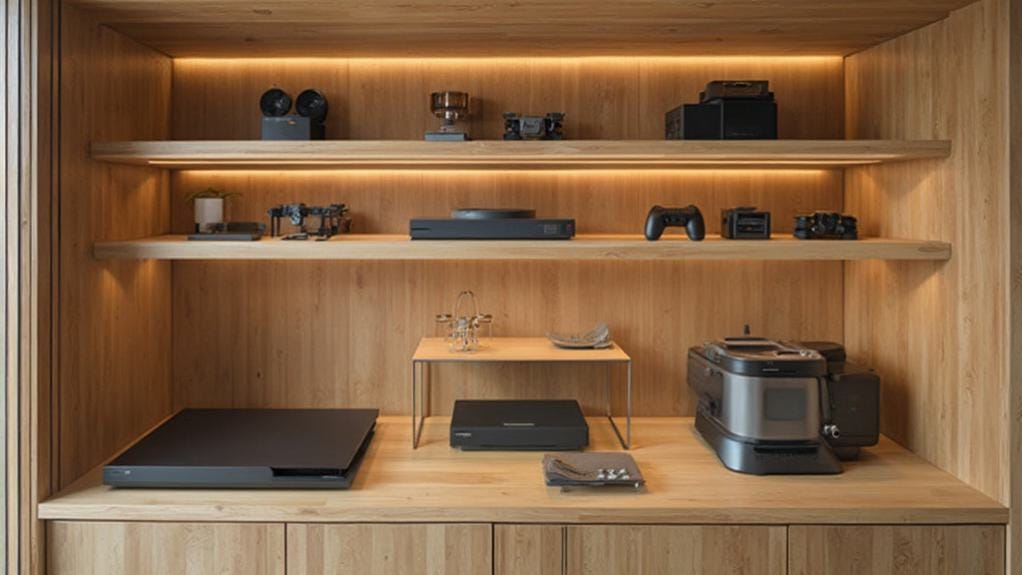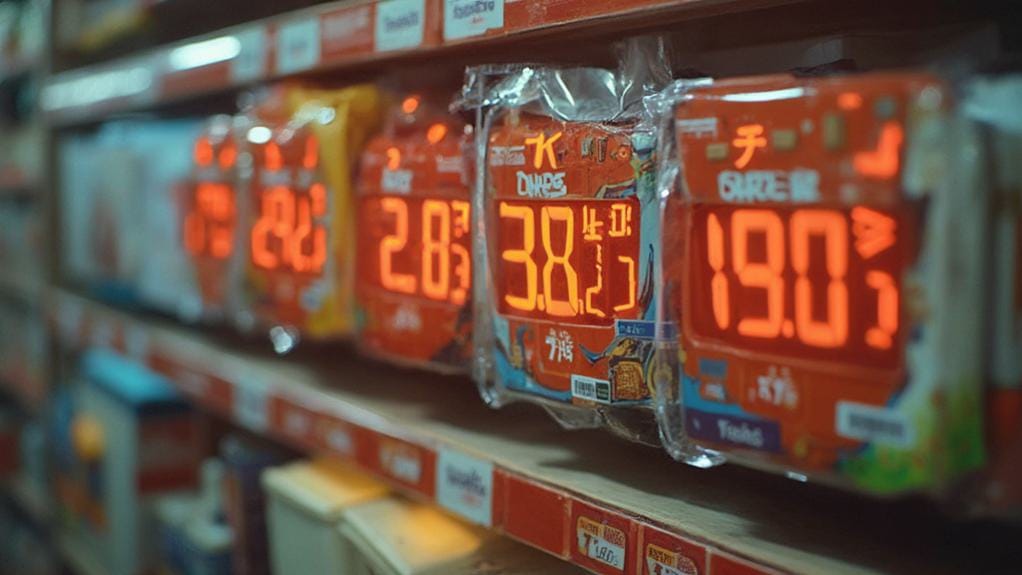Japan’s electronics shopping scene offers incredible opportunities for tech enthusiasts, but you’ll need to plan ahead.
I recommend bringing your passport for tax-free savings (10% off) and checking voltage compatibility since Japan uses 100V.
Head to districts like Akihabara for the latest gadgets, Shinjuku for major retailers, and Ginza for premium brands.
While most stores accept credit cards, carrying some cash is wise. You’ll find exclusive Japanese models, innovative appliances, and cutting-edge cameras at competitive prices.
Whether you’re hunting for a Zojirushi rice cooker or Sony headphones, there’s much more to discover in Japan’s tech paradise.
Tax-Free Shopping Requirements
Savvy shoppers looking to buy electronics in Japan can take advantage of tax-free shopping if they meet specific requirements.
I’ll help you navigate the eligibility rules so you don’t miss out on these valuable savings.
You’ll qualify if you’re a tourist or foreign visitor with a short-term stay visa, and you’ve got your passport properly stamped upon arrival – those automated gates might be tempting, but skip them if you want tax-free deals.
If you’re a Japanese national who’s been living abroad for over two years, you’re also eligible within your first six months back home.
Just remember, if you’ve been in Japan longer than six months or you’re currently working here, you won’t qualify.
And don’t forget – you’ll need your original passport when making purchases, as copies won’t cut it.
The consumption tax rate in Japan currently stands at 10%, making tax-free shopping a significant saving opportunity.
Travelers on a budget-friendly itinerary can combine tax-free shopping with other money-saving strategies to maximize their spending power in Japan.
Voltage and Power Considerations
Before plugging in your electronics in Japan, you’ll need to understand the country’s unique power system.
Japan uses 100V, which is lower than both the US (120V) and Europe’s hefty 220-240V, and there’s another quirk: the country is split between 50Hz and 60Hz frequencies.
I’ll let you in on a secret that’ll save you headaches: while your laptop and phone charger will work fine with just a simple plug adapter, anything that generates heat might give you trouble.
Your trusty hair dryer might wheeze along at half power, and that fancy coffee maker could take forever to brew. Consider using public transportation cards to offset the costs of buying new electronics in Japan.
If you’re bringing appliances from home, check their voltage compatibility – you’ll find this information on the device’s power label.
For non-compatible devices, you’ll need a voltage converter to avoid any shocking surprises. Setting aside travel budget early helps ensure you can purchase any necessary power adapters or voltage converters before your trip.
Top Shopping Districts

Tokyo’s electronics wonderland spans several distinct shopping districts, each with its own character and specialty.
If you’re after the full otaku experience alongside cutting-edge gadgets, I’d recommend starting in Akihabara, where multi-story complexes like Radio Kaikan will dazzle you with everything from vintage electronics to the latest tech innovations.
With convenient transit hubs nearby, getting between electronics districts is seamless using Tokyo’s extensive rail network.
For a more mainstream shopping adventure, you can’t go wrong with Shinjuku or Ikebukuro, where massive retailers like Bic Camera offer extensive selections under one roof.
When you’re in the mood for a premium shopping experience, head to Ginza‘s sleek showrooms, where you’ll find flagship stores of major brands like Sony and Apple.
Each district brings its own flavor to the electronics shopping scene, and I’d suggest visiting at least two to get the full experience.
For those seeking luxury travel experiences, combining your electronics shopping with stays at high-end districts like Ginza can elevate your entire Japanese retail adventure.
Major Electronics Brands
As you browse these electronics districts, you’ll encounter Japan’s most prominent tech brands dominating the shelves.
Industry giant Sony leads the pack with its innovative entertainment systems and cutting-edge gadgets, while Panasonic and Sharp offer extensive lineups of home appliances that’ll revolutionize your living space.
I’ve found that many international visitors overlook some equally impressive brands that locals swear by.
Just as Kyushu cuisine draws food enthusiasts from around the globe, these electronics stores attract tech-savvy shoppers seeking quality.
Keep an eye out for TDK’s superior audio equipment and Murata’s precise electronic components, which showcase Japanese engineering at its finest.
You might also want to check out Casio’s iconic watches and calculators, or Brother’s reliable printers and sewing machines.
These brands may not always grab international headlines, but they represent the same commitment to quality that’s made Japanese electronics world-famous.
Much like Kyoto’s traditional cuisine, these electronics manufacturers maintain exacting standards that reflect Japan’s dedication to preserving excellence in their craft.
Must-Have Japanese Electronics

Japanese electronics stores frequently showcase four essential product categories that I consider must-haves for any tech enthusiast.
I’d strongly recommend exploring their cutting-edge cameras and photography gear, where you’ll find incredible deals on Canon and Nikon equipment that’ll transform your photography game.
Just like Tokyo’s ramen culture, the city’s camera technology scene offers an authentic and unmatched experience.
For music lovers, I can’t emphasize enough how Japanese audio equipment, particularly Sony and Audio-Technica offerings, delivers unparalleled sound quality you won’t find elsewhere.
Their innovative home appliances, like Zojirushi’s game-changing rice cookers and Panasonic’s smart kitchen gadgets, have revolutionized my daily routine.
Finally, if you’re into gaming or smart home technology, you’ll be amazed by Nintendo’s exclusive releases and Sharp’s intelligent home solutions that seamlessly blend convenience with cutting-edge technology.
Many travelers choose to stay in Kichijoji area hotels when shopping for electronics due to the neighborhood’s excellent selection of tech stores and convenient location.
Store Types and Locations

When exploring electronics shopping in Japan, you’ll discover an extensive network of stores ranging from massive retail chains to specialized boutiques.
I recommend starting with the major players like Bic Camera and Yodobashi, where you’ll find everything from cameras to high-tech toilets under one roof.
For the ultimate electronics adventure, head to Akihabara, where Yodobashi’s nine-story flagship store towers like a tech paradise.
If you’re in Shinjuku or Shibuya, you’ll find plenty of Bic Camera outlets, while Ikebukuro hosts both Bic and Yamada Denki stores.
I particularly love exploring the smaller shops in Akihabara’s side streets, where you might stumble upon unique gadgets and incredible deals you won’t find in the bigger chains.
Planning ahead with family travel tips can help you navigate these bustling electronics districts more efficiently with children in tow.
Solo travelers can easily spend an entire day exploring these electronics wonderlands at their own pace, making it a perfect addition to any Japan itinerary.
Price Comparison Strategies

Smart shoppers in Japan rely heavily on price comparison tools to find the best deals on electronics. I always recommend starting with Kakaku.com, which you can easily navigate using Google Translate to compare prices across multiple retailers and check delivery charges.
When you’re comparing prices, don’t forget to factor in Japan’s 10% consumption tax, though you’ll be pleased to know there are tax-free options if you’re visiting as a tourist. As a first-time visitor, you should bring your passport to claim tax exemptions at participating stores.
I’ve found that retailers often sweeten the deal with appealing extras like extended warranties or special packaging, which can add significant value to your purchase.
Keep in mind that while Japanese consumers are quite price-sensitive, they’re also focused on quality, so you’ll want to balance cost against long-term value when making your decision.
While Japan is known for its safe shopping environment, you can shop with confidence at major electronics retailers knowing your consumer rights are well-protected.
Current Market Trends
How is Japan’s massive $37.42 billion electronics market evolving? I’m seeing some fascinating shifts that you should know about before making your next purchase.
The market’s experiencing a transformation as consumers become more cost-conscious due to inflation and a weaker yen.
Similar to Kyushu rail system, Japanese retailers are adapting their navigation systems to help shoppers easily locate products, much like the country’s famous vending machine culture.
Here are the most notable trends I’m observing:
- E-commerce now accounts for 46.1% of electronics purchases, though physical stores still dominate.
- Apple continues to reign supreme, especially in the smartphone segment.
- There’s a growing preference for value-focused products over premium offerings.
While the market’s projected growth is slowing down (-0.81% CAGR), I’m noticing Japanese consumers are making smarter choices, particularly gravitating toward retailers that offer multiple experiences under one roof.
You’ll find many shoppers combining their electronics hunting with dining and entertainment, making each shopping trip more purposeful and efficient.
Popular Gadget Categories
These shifting market dynamics shape what you’ll find on Japanese store shelves, so let’s look at the specific gadget categories worth your attention.
When I browse electronics stores, I’m consistently amazed by the sheer variety of portable devices, from cutting-edge smartphones to retro gaming consoles that’ll transport you back to the 90s. Before hitting the electronics stores, consider starting your day at Okinawa Churaumi Aquarium, one of Japan’s most impressive marine attractions.
You’ll discover an impressive array of home appliances that redefine convenience, like Zojirushi’s state-of-the-art rice cookers and robotic vacuum cleaners that make cleaning a breeze.
I’m particularly excited about the smart home ecosystem, where Sharp and NEC’s lighting systems seamlessly integrate with intelligent security cameras.
Don’t overlook the beauty and health tech section – I’ve found some real gems there, from Panasonic’s revolutionary nano-e hairdryers to ReFa’s innovative facial rollers that transform your skincare routine.
After a day of electronics shopping in Tokyo, you can unwind at Tsukiji Market, home to some of the city’s finest sushi establishments.
Payment and Shipping Options
Understanding payment and shipping logistics is essential when buying electronics in Japan.
You’ll find that while cash is still king in many places, digital payments are rapidly transforming the landscape.
Most major retailers accept credit cards and mobile payments like Apple Pay, though you might want to check if your card works internationally before your shopping spree.
Just like train tickets bookings, many transactions can now be completed entirely through digital means.
When it comes to shipping your precious electronic finds, you’ve got several reliable options:
- Door-to-door delivery through Yamato, perfect for those bulky gaming consoles
- Convenient store pickup points if you’re constantly on the move
- International shipping via FedEx or DHL, with customs-friendly packaging
Remember that items valued over 10,000 JPY might incur additional duties, so I’d recommend factoring that into your budget when planning your electronic purchases.
Having reliable internet access is crucial for tracking shipments and managing digital payments while shopping in Japan.




